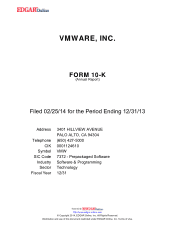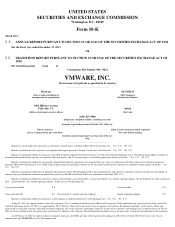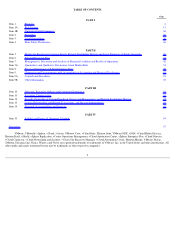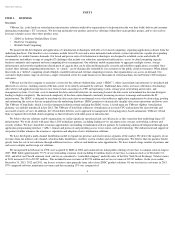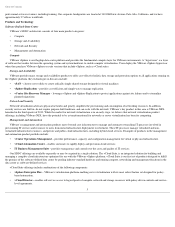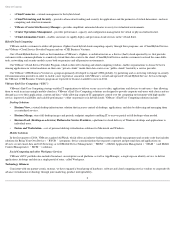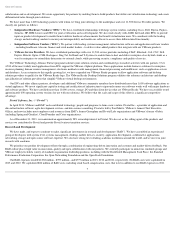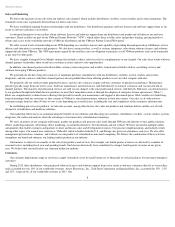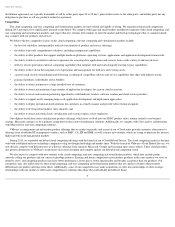VMware 2013 Annual Report Download - page 6
Download and view the complete annual report
Please find page 6 of the 2013 VMware annual report below. You can navigate through the pages in the report by either clicking on the pages listed below, or by using the keyword search tool below to find specific information within the annual report.
Table of Contents
PART I
Overview
VMware, Inc. is the leader in virtualization infrastructure solutions utilized by organizations to help transform the way they build, deliver and consume
information technology (“IT”) resources. We develop and market our product and service offerings within three main product groups, and we also seek to
leverage synergies across these three product areas.
We pioneered the development and application of virtualization technologies with x86 server-based computing, separating application software from the
underlying hardware. The benefits to our customers include lower IT costs and a more automated and resilient systems infrastructure capable of responding
dynamically to variable business demands. Our broad and proven suite of virtualization technologies are designed to establish secure and reliable IT
environments and address a range of complex IT challenges that include cost reduction, operational inefficiencies, access to cloud computing capacity,
business continuity and corporate end-user computing device management. Our solutions enable organizations to aggregate multiple servers, storage
infrastructure and networks together into shared pools of capacity that can be allocated dynamically, securely and reliably to applications as needed. Once
created, these internal computing infrastructures, or “clouds,” can be dynamically extended by our customers to the public cloud environment. When linked,
this results in a “hybrid” computing cloud of highly available internal and external computing resources that organizations can access on demand. Our
customers' deployments range in size from a single virtualized server for small businesses to thousands of virtual machines for our Fortune 1000 enterprise
customers.
VMware was the first company to articulate a vision for the software-defined data center (“SDDC”), where increasingly infrastructure is virtualized and
delivered as a service, enabling control of the data center to be entirely automated by software. Traditional data centers are loose collections of technology
silos where each application type has its own vertical stack consisting of a CPU and operating system, storage pool, networking and security, and
management systems. Over time, costs to maintain the data center infrastructure are increasing because the data center environment has become divergent,
leading to higher complexity. The increased complexity of the data center demands constantly increasing resources to manage and maintain the IT
infrastructure. The SDDC is designed to transform the data center into an on-demand service that addresses application requirements by abstracting, pooling
and automating the services that are required from the underlying hardware. SDDC promises to dramatically simplify data center operations and lower costs.
The VMware vCloud Suite, which is our first integrated solution toward realizing the SDDC vision, is based upon our VMware vSphere virtualization
platform, was initially introduced in late 2012. The VMware vCloud Suite addresses virtualization of not only CPU and memory but also networks and
associated security services. In addition, the vCloud Suite delivers a new approach to management, leveraging policy-based automation. VMware vCloud
Suite is engineered for hybrid cloud computing so that it federates with other pools of infrastructure.
We believe that our solutions enable organizations to realize significant operational and cost efficiencies as they transition their underlying legacy IT
infrastructure. We work closely with more than 1,200 technology partners, including leading server, microprocessor, storage, networking, software and
security vendors. We have shared the economic opportunities surrounding virtualization with our partners by facilitating solution development through open
application programming interface (“APIs”) formats and protocols and providing access to our source code and technology. The endorsement and support of
our partners further enhances the awareness, reputation and adoption of our virtualization solutions.
We have developed a multi-channel distribution model to expand our presence and reach various segments of the market. We derive the majority of our
revenues from our indirect sales channel, which includes distributors, resellers, system vendors and systems integrators. We believe that our partners benefit
greatly from the sale of our solutions through additional services, software and hardware sales opportunities. We have trained a large number of partners and
end users to deploy and leverage our solutions.
We incorporated in Delaware in 1998, were acquired by EMC in 2004 and conducted our initial public offering of our Class A common stock in August
2007. EMC holds approximately 79.7% of our outstanding common stock, including 43 million shares of our Class A common stock as of December 31,
2013, and all of our Class B common stock, and we are considered a “controlled company” under the rules of the New York Stock Exchange. Total revenues
in 2013 increased 13% to $5,207 million . This included license revenues of $2,270 million and services revenues of $2,937 million . In the years ended
December 31, 2013, 2012 and 2011, our license revenues came primarily from sales of our SDDC product solutions. Of our total services revenues in 2013,
87% comprised software maintenance revenues and the remaining 13% was comprised of
4
ITEM 1.
BUSINESS
• SDDC or Software-
Defined Data Center
• End-
User Computing
•
Hybrid Cloud Computing

